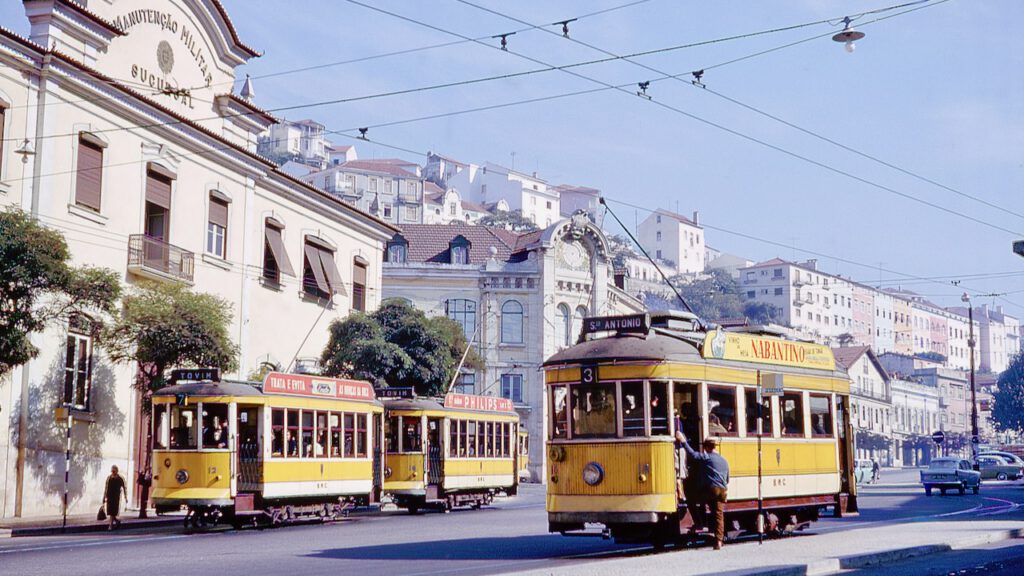
Coimbra was one of the five places in Portugal that had an electric tram system. The city is situated about 200 km north of Lisboa and 120 km south of Porto and dates from the Roman period. The oldest part of the city “Alta” or “Almedina” occupies an irregularly-shaped hill overlooking the Rio Mondego. Already in the Middle Ages the “Baixa” (lower town) was built along the river. Here the principal shops and other commercial activities are located. The Alta and the Baixa are separated by the main shopping street. This street has two names, Rua Ferreira Borges for the southern part and Rua Visconde da Luz for the slightly wider northern part, but they are in line with each other and in practice make one street.
The University of Coimbra is the oldest of Portugal and one of the oldest world-wide: founded in 1290 in Lisboa, but definitive located in Coimbra since 1537. The main buildings of the university are on the top of the hill. The path from the Baixa to the university is far too steep to make a tramline possible and the trams had to go around the hill to the other side where the slope is less steep, but still challenging.
In 1864 the railway between Lisboa and Porto got fully in service, except for the short section between Porto and VN de Gaia across the Douro. This gave Coimbra good connections with both the largest cities of the country. The railway station is located about 2 km from the old city.
Jump to the subject:
Mule trams
Electric trams, the first years
Electric trams, the period 1920-1960
Electric trams, the final decades
Depots, Power supply and Tram museum
Rolling stock
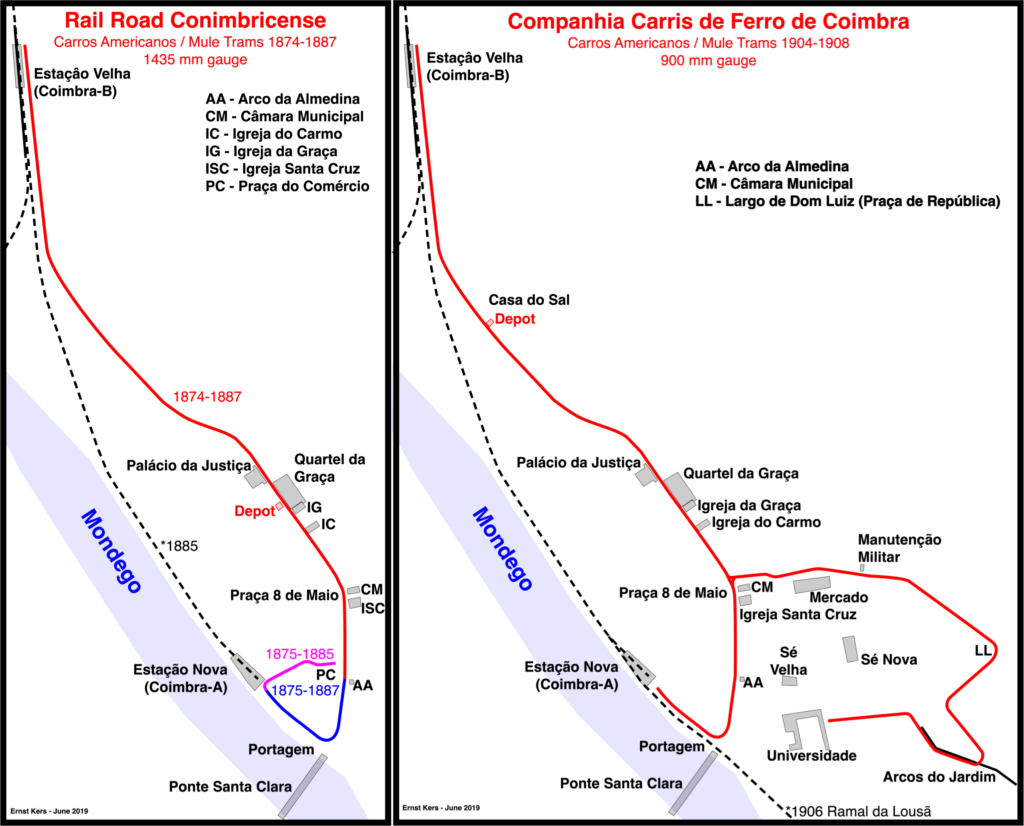
Rail Road Conimbricense (RRC)
On 17 September 1874 a “Caminho de Ferro Americano” (horse tramline) was opened between the Calçada ao Arco da Almedina (now Rua Ferreira Borges) and the railway station by the “Rail Road Conimbricense” (RRC). The official inauguration had taken place two days before. The provisional timetable showed 4 journeys daily connecting at the railway station with the trains of the Companhia Real dos Caminhos de Ferro.
The line was extended by May 8, 1875 from Calçada ao Arco da Almedina via Largo P. Carlos I (now Portagem) and Largo das Ameias through the very narrow Rua das Solas (now Rua Adelino Veiga) to Praça do Comércio. The RRC transported also freight for which there was a siding to the goods station of the railway station. Crossing places were in Rua da Sofia, Largo de Sansão (now Praça 8 de Maio) and Largo P. Carlos I.
Little is known about the earliest trams in Coimbra. They were manufactured by Starbuck, United Kingdom. At least one of the cars had an imperial with seats on the roof. In 1884 the RRC had 5 passenger cars, 4 freight wagons and 12 mules for pulling the vehicles. The depot of the cars and the stables of the mules were in the Rua da Sofia, opposite to the Quartel (barracks) da Graça.
End of the Rail Road Conimbricense
For ten years the tramline flourished well, but on 18 October 1885 an about 2 km long branch railway was opened between the station and Largo das Ameias near the city centre. The station on the main line was now called “Coimbra-B”, locally known as “Estação Velha” (Old Station). The station in the city was called “Coimbra-A” (or just “Coimbra”) locally known as “Estação Nova” (New Station). The competing steam trains caused a severe drop in the number of passengers and amount of freight for the tram company. The dispatch goods station of the RRC was moved from Praça do Comércio to Praça 8 de Maio. Apparently the short section between the Estação Nova (Largo das Ameias) and Praça do Comércio was not used anymore. But the small tram company inevitable lost the battle with the large railway company. The end of the RRC came at the beginning of April 1887.
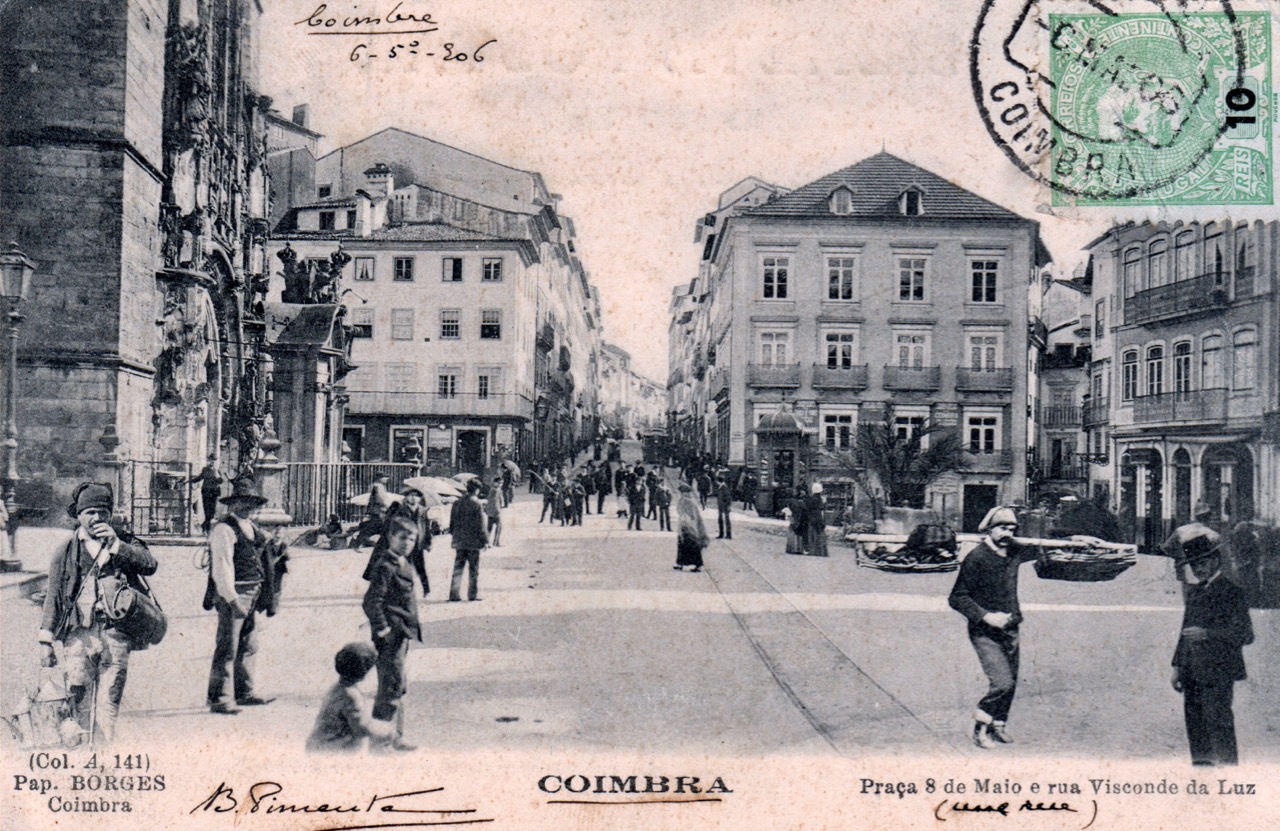
Companhia Carris de Ferro de Coimbra (CCFC)
In January 1903 the City Council granted a provisional concession for a period of 30 years for the construction of a new mule tram network to a new company with the name Companhia Carris de Ferro de Coimbra (CCFC). The new company adopted the same gauge as Lisboa (900 mm). It will not have been coincidence that the CCFC came to existence short after the Carris de Ferro de Lisboa had electrified its network and had mule trams and rails for sale.
On 1 January 1904 the first line was opened between Estação Nova and Estação Velha. The second route opened on 4 February connecting the Praça 8 de Maio with the Largo Porta Férrea, in front of the University.
The network was complete single track with a few passing loops, although it’s unknown how many and where exactly. The depot was located across the Rua da Figueira da Foz, near the Casa do Sal. The CCFC operated three lines, the number of return trips according to a schedule of 1907:
- Estação Nova – Estação Velha. (9 return trips)
- Estação Nova – Universidade. (25 return trips)
- Universidade – Estação Velha. (9 return trips)
Mule trams were not the ideal type of urban transport on the steep gradients to the Alta. The mule trams departed from the Baixa with two mules, two more were attached at the bottom of the Avenida Sá da Bandeira and at the Arcos do Jardim a further two mules were added. With six mules a small tramcar was hauled up the road next to the Aqueduto de São Sebastião until the Arco do Castelo.
Few details are known about the trams of the CCFC, even not how many there were. With taking into account the size of the network there were likely not more than about half of a dozen. Doubtless all were second hand bought from the CCFL in Lisboa and there were open and closed types. There must have been also a few freight cars as the company transported mail bags between the Central Post Office and the Estação Velha and coal to the Gas factory.
A failed attempt to electrify the network and the end of the CCFC
Already in December 1904 the concessionaire proposed replacement of animal traction by electric traction. The Coimbra City Council immediately agreed. However investors were less enthusiast, which meant that because of lack of capital the progress of the project was slow. Nevertheles the CCFC continued with importing materials and presenting projects to realise the new electric network, but the insurmountable financial problems caused first in March 1908 that the installation work on the electric traction, and then on 31 August 1908 also the mule tram operations were suspended.
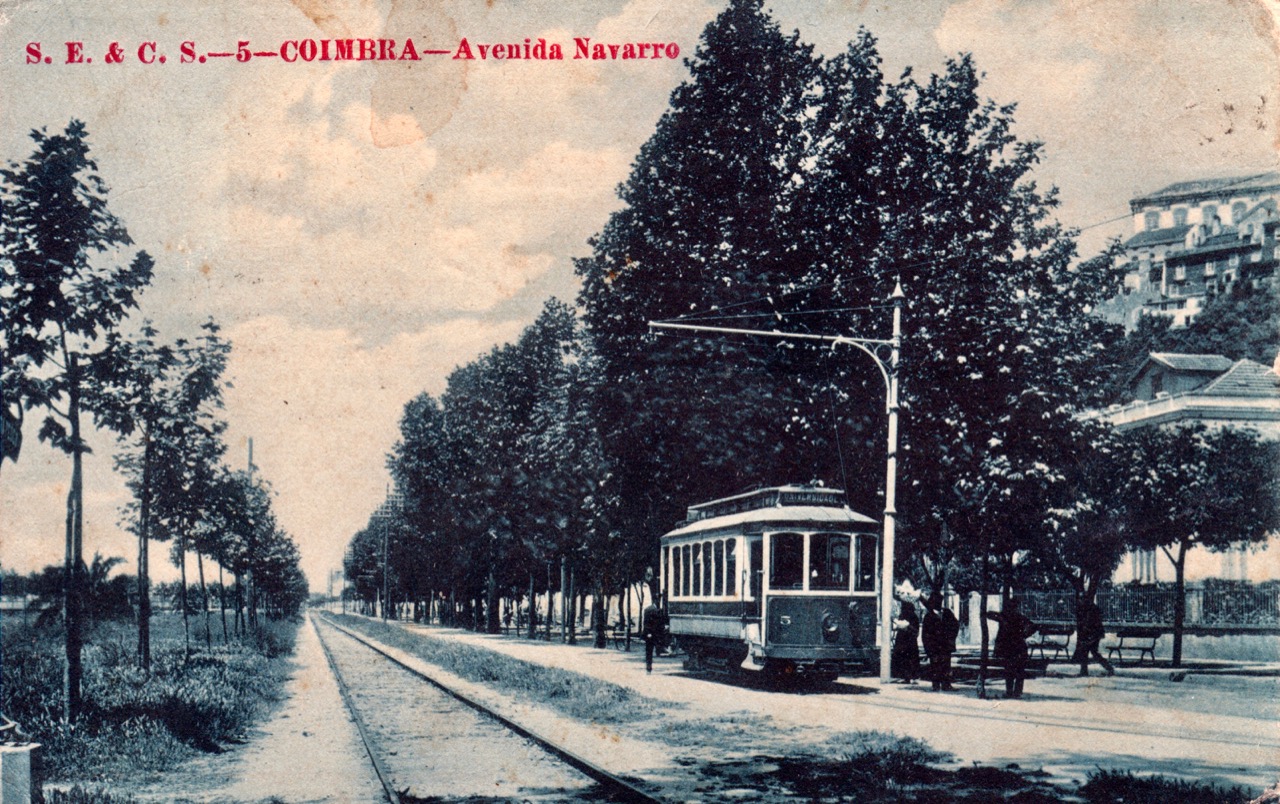
Câmara Municipal de Coimbra (CMC)
With the success of the electric trams in Porto and Lisboa and the failure of the CCFC to electrify the Coimbra mule tram network, the city council decided to take matters into their own hands. The contract was awarded to Thomson-Houston-Iberica in September 1909. They had to deliver:
- Five electric trams.
- Installation of rails with 1000 mm gauge and overhead lines.
- A steam-powered generating plant.
- A depot with space for eleven trams, a repair workshop and a paint shop.
Early 1910, the installation work for electric traction began. In June 1910, the first electric trams arrived and on 25 November test runs started.
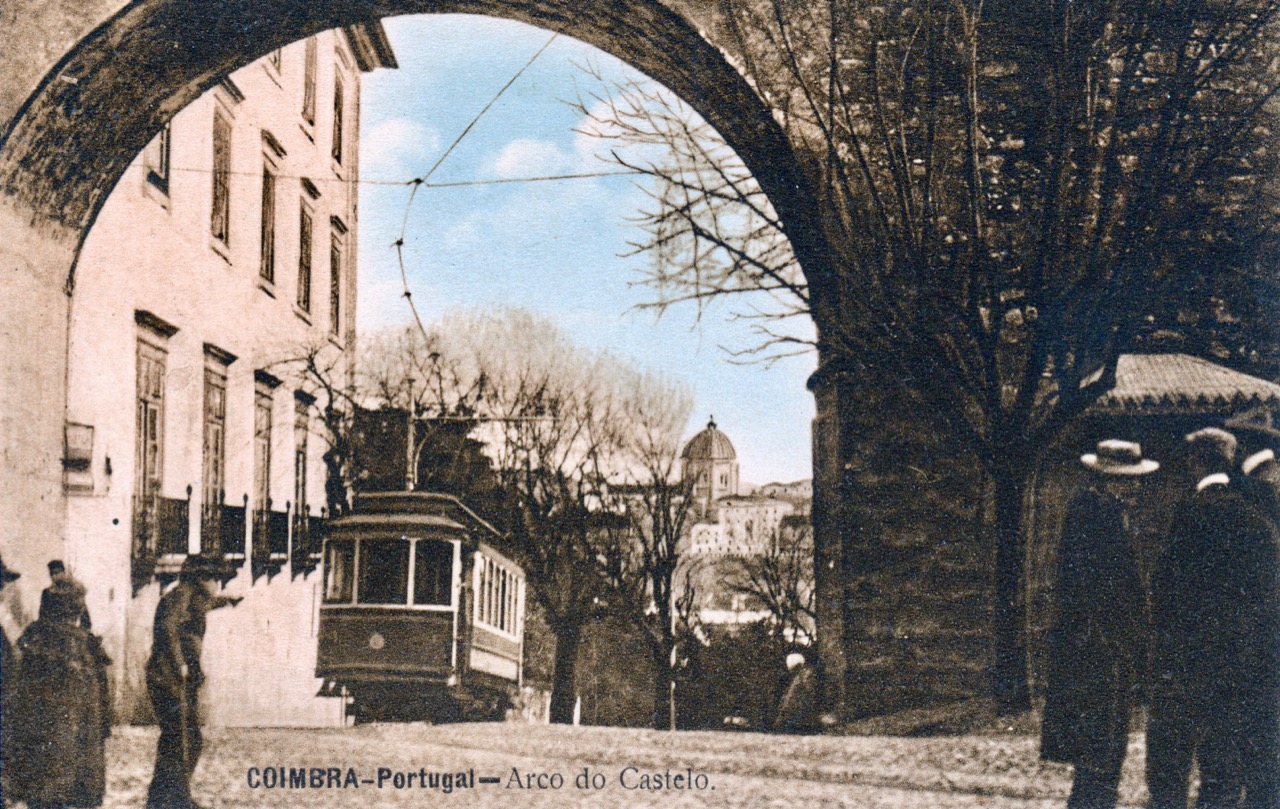
The first years
On 1 January 1911 the tram services were inaugurated. In 1912 two more electric trams similar to the first five arrived and on 24 May 1913 a new route between Alegria and Calhabé was opened. Between 1913 and 1927 there were no changes in the tram network. Four lines were operated, identified by colours:
- Green: Estação Nova – Portagem – Praça 8 de Maio – Praça da República – Arcos do Jardim – Ladeira do Castelo – Rua Infante D.Augusto (now Rua Larga, but at that time the area was still one with narrow medieval streets) – Universidade (Largo Porta Férrea) v.v.
- Red: Alegria (“remise”) – Av. Navarro – Portagem – Praça 8 de Maio – Rua da Sofia – Estação Velha v.v.
- White: Estação Nova – Portagem – Praça 8 de Maio – Praça da República – Cruz de Celas – Olivais v.v.
- Pink: Portagem – Av. Navarro – Rua do Brasil until Calhabé v.v.
All routes were single track with a few passing loops. As there were only seven trams, there will have been at most two trams working on the same route.
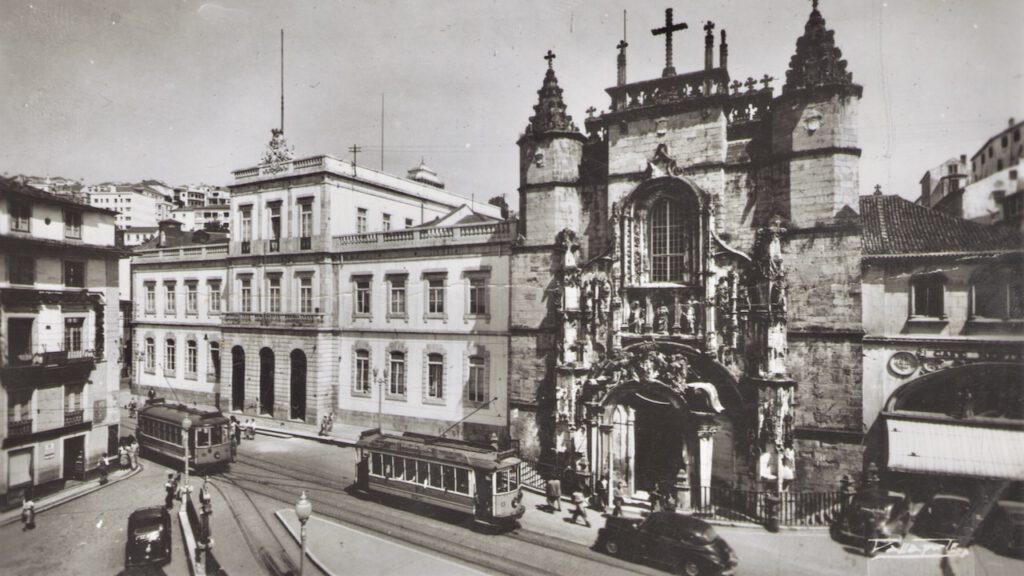
Serviços Municipilizados de Coimbra (SMC)
On 27 April 1920 the Serviços Municipalizados de Coimbra was created. This new organisation had autonomy in relation to City Council, providing the services of Electric Trams, Water and Gas. In its 1921 Annual Report, the SMC drew attention to the need to develop the network of electric trams with the construction of new lines, with installing double track if space allowed, on the busiest parts of the network, with extending the fleet and improving the power plant. Most of these plans were realised from 1928 until 1934:
- 1 November 1928: new tramline (5) to Montes Claros. This line was soon after extended to Cruz de Celas.
- 16 December 1928: double track between the Arco da Almedina / Rua Ferreira Borges up to Arcos do Jardim.
- 24 February 1929: the connection of the Calhabé line to Arcos do Jardim, creating the circular line (6) to Calhabé.
- 19 May 1929: new route Cumeada-Olivais, between Arcos do Jardim, passing along the Penedo da Saudade, then following Av. Dias da Silva reaching its terminus at Olivais. (line 3)
- 1932: Olivais to the Church of Sto. António dos Olivais.
- 1932: the line in Rua Abílio Roque (today Rua Padre António Vieira) becoming the Museum line. First numbered 8, it was in 1933 already indicated as line 1-Museu. This was the steepest slope of the network, comparable with the Calçada de Sto. André and the Calçada de São Francisco in Lisboa.
- September 1932: Extending the double track from Arcos do Jardim to Universidade.
- 1 July 1934: the line connecting Museu to Universidade, combining the Universidade and Museu lines into one line 1 with a loop through the Alta.
The plan for a tramline across the narrow lattice-girder Mondego bridge to Santa Clara couldn’t be realised because the Portuguese Railway company (CP) didn’t allow the necessary rail crossing with the Ramal da Lousã. Instead in 1947 Portugal’s first trolleybus line was opened on this route.
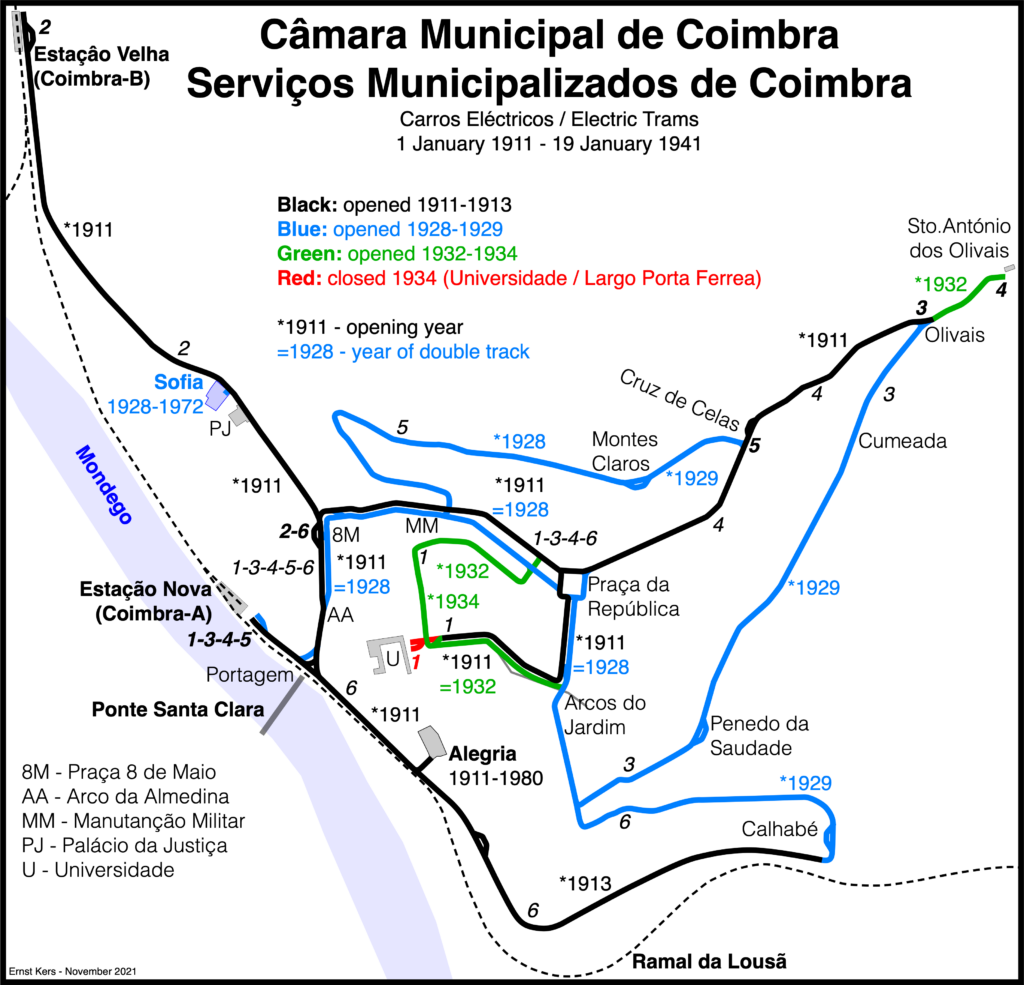
With the extensions of the network also route numbers were introduced, although the use of colours was retained too. This all resulted in the network at its largest extend:
- 1 (green): Estação Nova – Portagem – Praça 8 de Maio – Praça da República – Arcos do Jardim – Universidade – Museu – Praça 8 de Maio – Portagem – Estação Nova. The loop was operated in both directions.
- 2 (red): Praça 8 de Maio – Rua da Sofia – Estação Velha v.v.
- 3 (white): Estação Nova – Portagem – Praça 8 de Maio – Praça da República – Arcos do Jardim – Penedo da Saudade – Cumeada – Olivais v.v.
- 4 (yellow): Estação Nova – Portagem – Praça 8 de Maio – Praça da República – Cruz de Celas – Olivais – Sto. António dos Olivais v.v.
- 5 (blue): Estação Nova – Portagem – Praça 8 de Maio – Largo da Conchada – Montes Claros – Cruz de Celas.
- 6 (pink): Praça 8 de Maio – Praça da República – Arcos do Jardim – Rua dos Combatentes – Calhabé – Rua do Brasil – Av. Navarro – Portagem – Praça 8 de Maio. Circular line operated in both directions.
On January 19, 1941 services and the numbering of several tramlines were altered. The services of the lines 3 and 4 were combined into a large loop getting the number 3 for the counter clockwise direction and the number 3/ for the clockwise direction. The lines 5 and 6 became 4 and 5 respectively. The “new” line 4 was extended to the church of Sto. António dos Olivais.
On 26 July 1944 line 1 was divided again in two because of the demolishing of part of the Alta, a crime wiping out a part of the heritage of the old medieval city. This occurred to give place to the new buildings of the university. Later it was to trolleybuses to return here, but now between the pompous new buildings of the University. The new tram termini changed location a few times in pace with the progress of the demolishing works. Finally the termini were at the Largo do Castelo near the (old) Hospital da Universidade (line 1-Universidade) and at the top of Couraça dos Apóstolos (line 1-Museu).
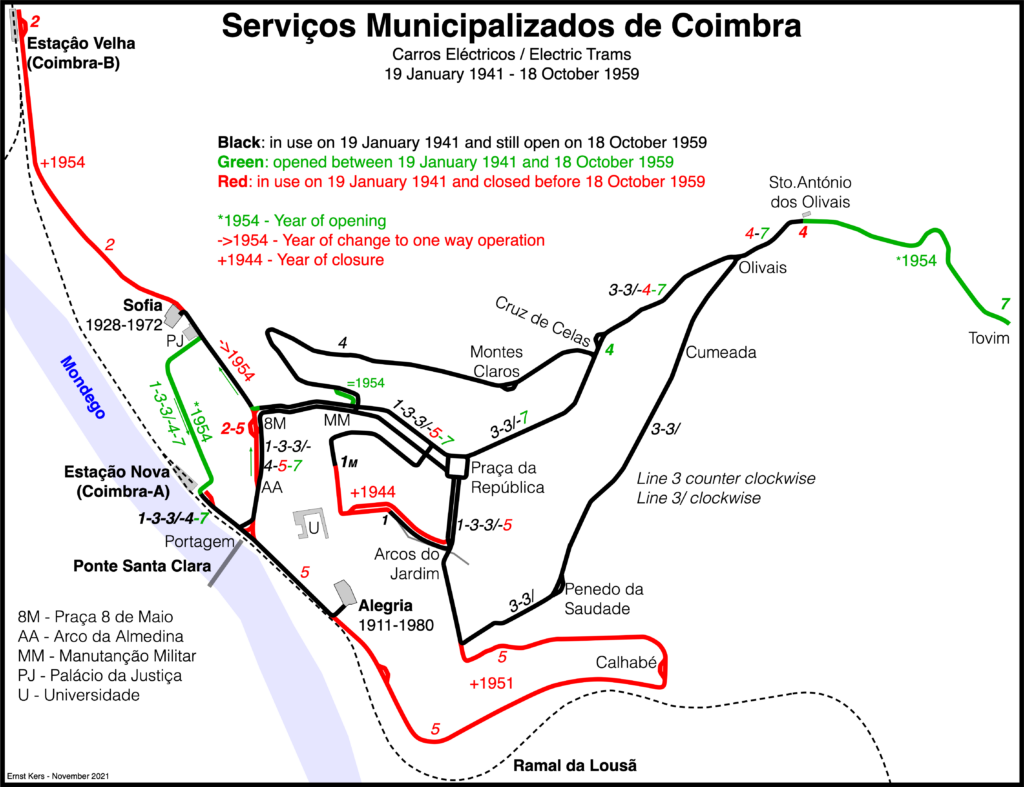
The long single track sections of the network caused long waiting times at the passing loops and the ends of the double track sections. Installing more double track was costly. As a trial on 27 April 1947 one way working was introduced for the loop of line 3, the Monte Claros route of line 4 and the whole of line 5. It meant that line 3 trams only went counter-clockwise through the Cumeada loop, line 4 trams went inbound via Praça da República instead of Monte Claros and line 5 trams only operated counter-clockwise. Protests were heavy because for many people this meant long detours. Soon the changes were reversed.
The increasing number of passengers also required more vehicles. As the experiences with the in 1947 opened trolleybus line across the bridge to Santa Clara were good, the decision was made to acquire trolleybuses instead of trams. On 10 March 1951 circular tramline 5 was replaced by a new circular trolleybus line with the same number. The clockwise running trolleybuses carried the number 5/. This made it possible to increase the number of trams working on the remaining tramlines. Photos prove that during busy times the trams often ran in pairs, without doubt because the constraints of the single-track routes prevented to have shorter headways.
1954 brought many changes. On 28 May the about 1.1 km long route from Sto.António dos Olivais to Tovim was opened with the inauguration of line 7: Estação Nova – Tovim. On 3 September 1954 the trams on line 2 were replaced by buses. This also meant the end of the trailer operations as trailers were only used on the lines 2 and 5.
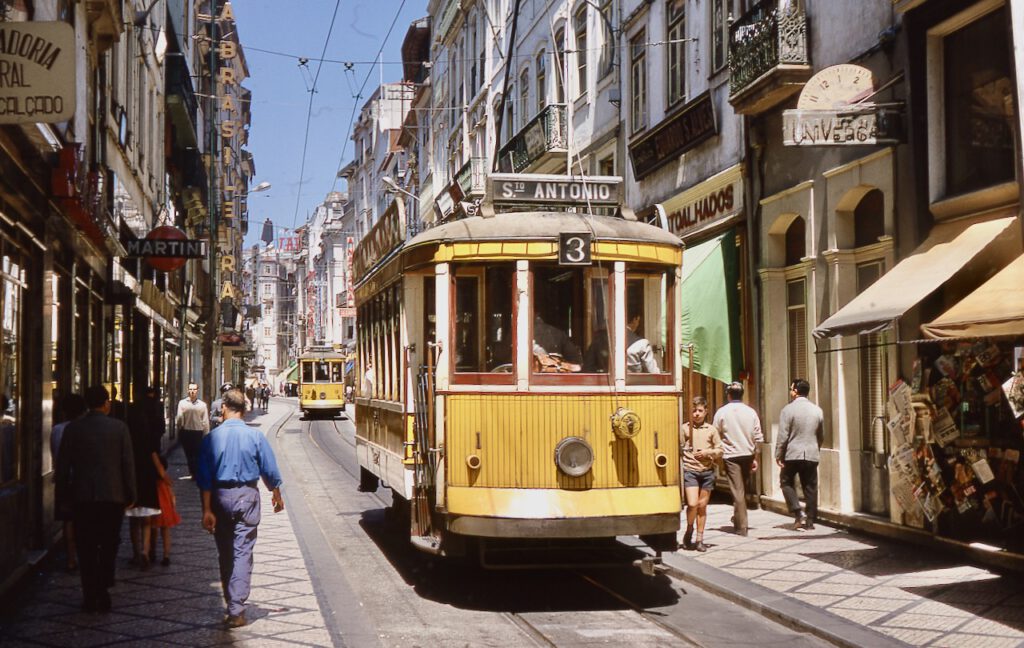
The new, wider Santa Clara bridge was inaugurated on 30 October 1954 and with this occasion also the Ruas Ferreira de Borges and Visconde da Luz were changed to one way traffic: northbound from Portagem to Praça 8 de Maio. For the trams and trolleybuses a one-way loop was created in the Baixa: Rua da Sofia – Rua Dr.Manuel Rodrigues – Av.Fernão de Magelhães – Estação Nova – Av.Navarro – Portagem – Rua Ferreira Borges – Rua Visconde da Luz – Praça 8 de Maio. Portagem became the Baixa terminus of the tramlines 1, 3, 3/, 4 and 7. With this change the single track bottle-necks of Rua Ferreira Borges – Portagem and Portagem – Estação Nova was eliminated.
On 18 October 1959 the operations were changed. Line 1-Universidade was replaced by a variation of trolleybus line 5. That didn’t mean line 1-Museu was remaining as the only line 1, for a new line 1 to Penedo de Saudade was created on the same date. This line used a new laid single track in Rua Santa Teresa creating a one-way loop for Penedo da Saudade. To reduce delays by waiting in the passing loops, also on 18 October 1959 the two-way working on the Montes Claros, Celas and Cumeada routes was changed to one way with the Celas route only used by inbound, and both others by outbound trams. As result the only remaining single-track two-way routes were those of line 1-Museu between Avenida Sá da Bandeira and Couraça dos Apóstolos, and line 7 between Olivais and Tovim. To provide a direct service between Olivais and Arcos do Jardim in 1960 a new, one way circular tramline 8 appeared.
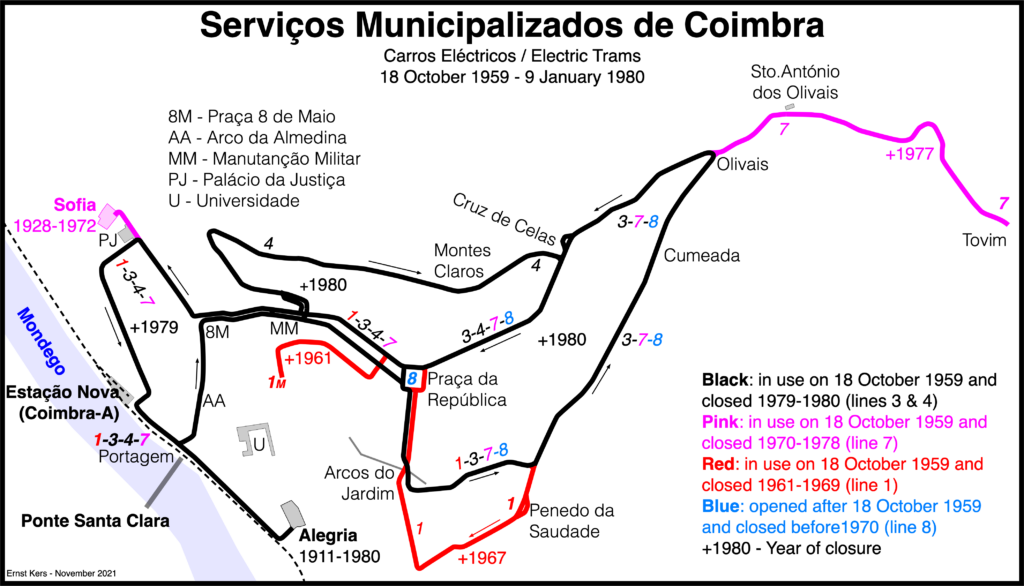
The final decades
By early 1961 the network consisted the following lines:
- 1-Penedo de Saudade: Portagem (Baixa loop) – Praça da República – Arcos do Jardim – Rua Santa Teresa – Penedo da Saudade – Arcos do Jardim – Praça da República – Portagem (Baixa loop).
- 1-Museu: Portagem (Baixa loop) – Couraça dos Apóstolos v.v.
- 3: Portagem (Baixa loop) – Praça da República – Arcos do Jardim – Rua Santa Teresa – Cumeada – Olivais – Cruz de Celas – Praça da República – Portagem (Baixa loop).
- 4: Portagem (Baixa loop) – Montes Claros – Cruz de Celas – Praça da República – Portagem (Baixa loop).
- 7: Portagem (Baixa loop) – Praça da República – Arcos do Jardim – Rua Santa Teresa – Cumeada – Olivais – Sto.António dos Olivais – Tovim v.v. but in the opposite direction via Cruz de Celas instead of Cumeada.
- 8: Praça da República – Arcos do Jardim – Rua Santa Teresa – Cumeada – Olivais – Cruz de Celas – Praça da República. (circular one way counter-clockwise)
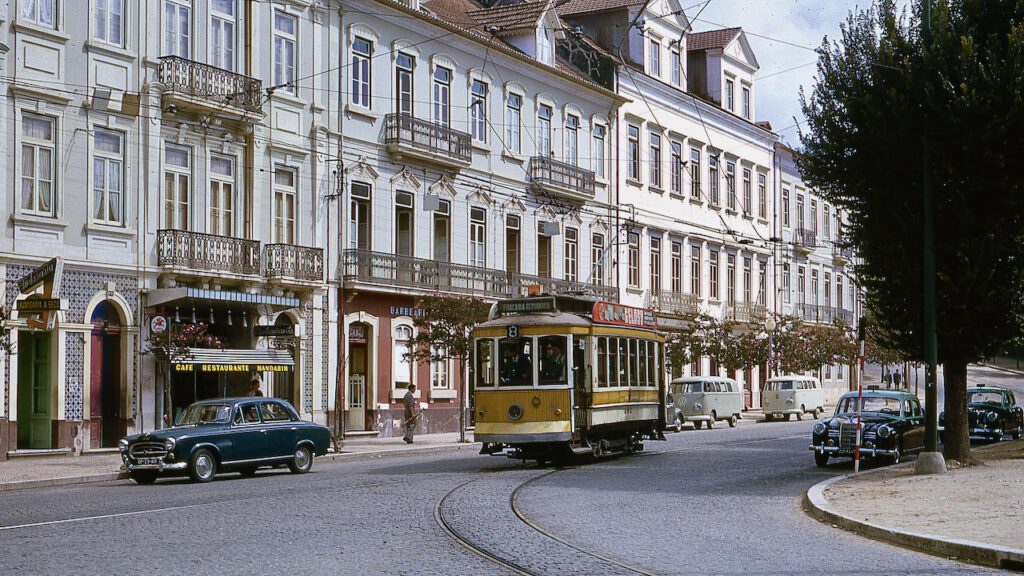
The only later changes were suspensions:
- 10 May 1961 line 1-Museu
- 18 June 1967 line 1-Penedo da Saudade
- 21 August 1967 line 8. Replaced by a new trolleybus line with the same number. This trolleybus line had the same route and direction trough the Olivais loop as the old tramline 3/: the trams of line 3 worked counter-clockwise and trolleybuses of line 8 clockwise.
- 19 February 1977 line 7, leaving the lines 3 and 4 as the only remaining.
In 1978, a new connection was installed on line 4 from the Avenida Sá da Bandeira into the Rua da Manutenção Militar. But this was only a prelude to the inevitable end. Works for a new sewer system in the Baixa caused that on 2 May 1979 the tram routes were curtailed to Manutenção. Line 3 reversed using the cross-over at Manutenção. Line 4 became a one-way circular line using the connection from Av.Sá da Bandeira to Rua da Manutenção Militar. Returning to the Alegria depot could only be done with police escort. All cars that operated during the day (three on line 3, two on line 4 and sometimes a sixth that had been out on trial) formed a convoy of trams with in front a police vehicle using floodlights for the journey against the traffic flow to Alegria. The last time was in the night of 8 to 9 January 1980 close to 1 am.
Power supply
Like all other Portuguese electric tram systems, also in Coimbra the production of the electric energy was at first an own activity. The Coimbra power plant was on the same site as the Alegria depot. It consisted of two large water-tubed boilers from Babcock & Wilcox with 300 square metres of heating surface; two high speed vertical cylinder steam engines from Bellis & Marcon of 390 HP rating, coupled to two dynamos of 180 Kilowatts by General Electric.
In July 1929 direct electrical power was taken from the power station of União Eléctrica Portuguesa (UEP), bypassing the power plant at Alegria, which then produced energy for electric trams only in case of failure or lack of power of the supply from the UEP. From 1933 to 1941 the power station at Alegria worked only for conservation purposes. However, in February 1941 when a cyclone hit the country, the Alegria power station produced during a few weeks energy for the trams and for the public lighting of the city, while the damage to the power lines of the UEP was repaired. In April 1943, the SMC began to receive also power from a second supplier, the Companhia Eléctrica das Beiras (CEB). The power station of Alegria was dismantled and the boilers were sold in November 1943.
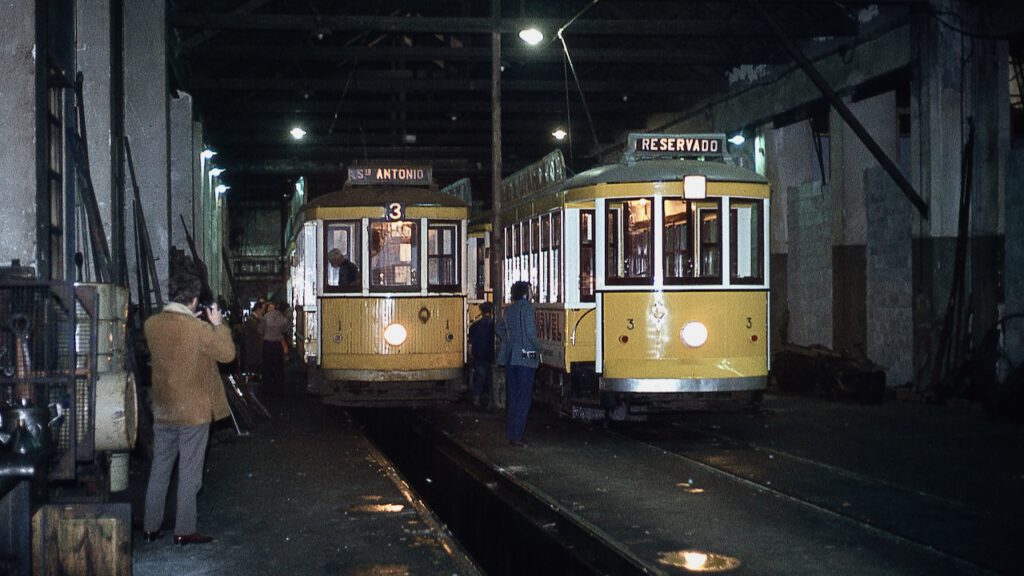
Depots
At the opening of the system the depot was in Rua da Alegria. There was capacity for eleven cars, along with the repair shop, paint-shop and material store. This capacity sufficed until the extension of the network and fleet that started in the second half of the 1920’s. On June 28, 1928 a new depot was opened. This was located on the site of the old Gas factory in Rua da Sofia and had space for 24 trams. The Sofia depot had a traverser which served six parallel lines. The workshops were retained in Alegria and later this site was also used as depot for the buses and trolleybuses. With the dismantling of the power station the capacity as a depot of Alegria could be increased. In 1972 the buses and trolleybuses moved to Guarda Inglesa, a new depot at the other side of the Mondego river. This made it possible to move the trams back to Alegria and close the Sofia depot in that same year.
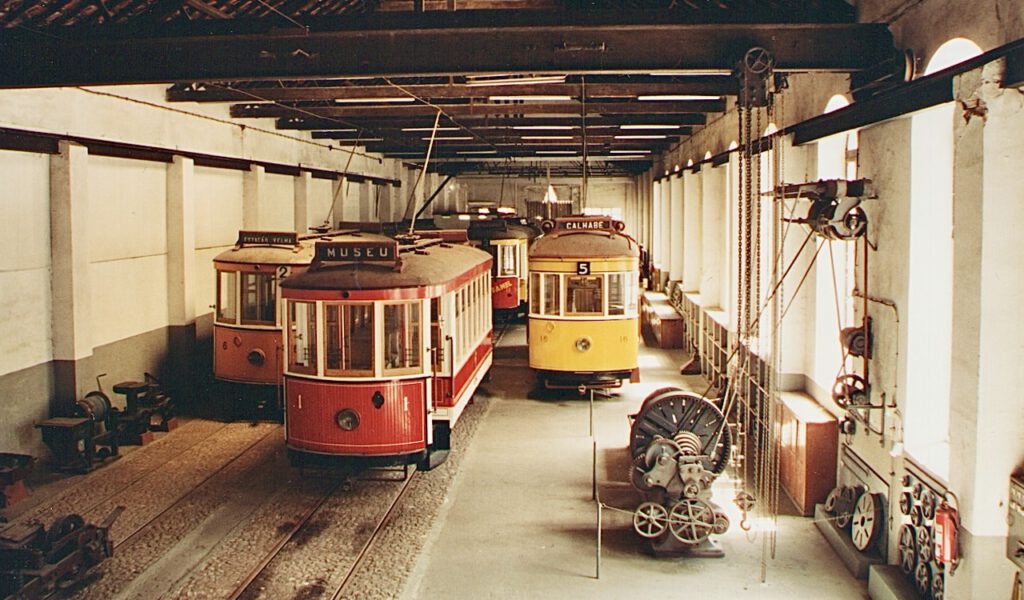
Tram museum
After closure of the tram system, a small museum was installed in the former workshops at Alegria. For many years it was free accessible during workdays. Late in the 1990’s the museum was closed and the trams were moved to Guarda Inglesa. For several years the old space of the workshops / museum was used for other cultural activities. Later the trams returned, but the museum can now only be visited by groups after making an appointment.
Rolling stock of the CMC/SMC
The maximum fleet that existed in Coimbra, was 20 electric trams, 2 trailers and 2 freight trailers. The cars were allegedly originally red, although the Brill works photo of no.1 suggests otherwise. Soon, if not from the beginning, the colour of the trams was yellow. Most cars had only hand and rheostatic brakes.
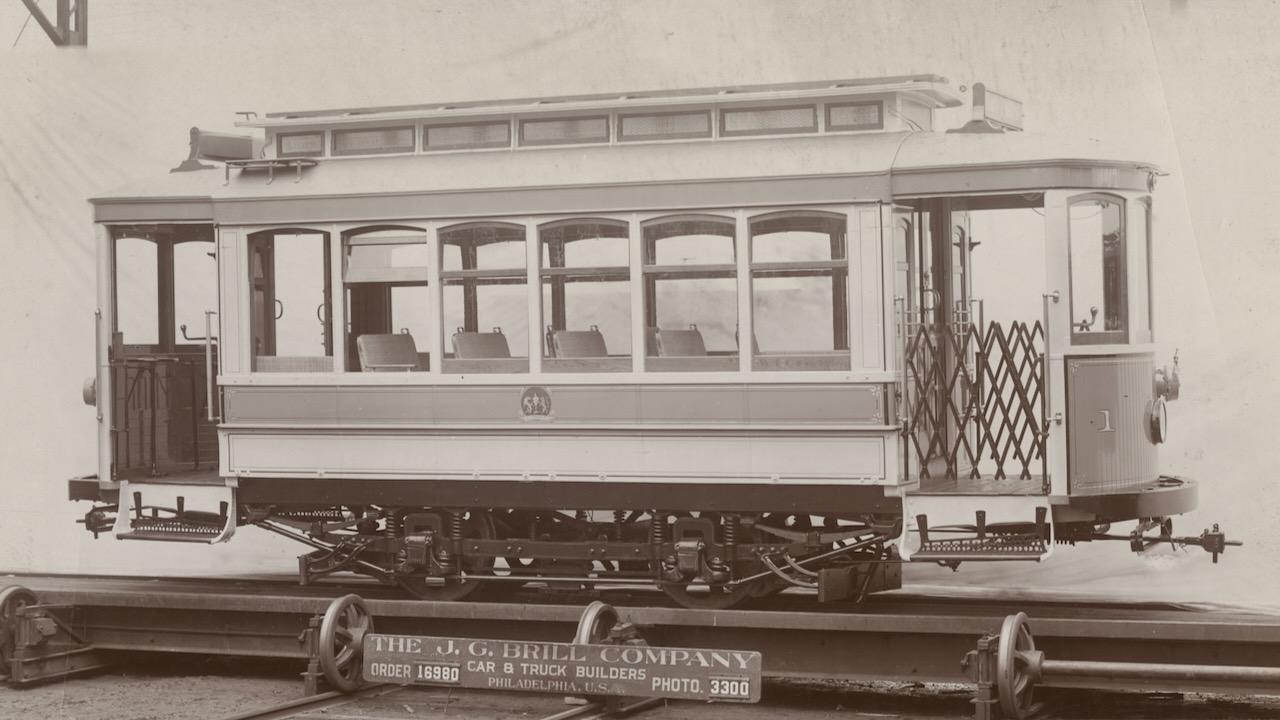
Series 1-8 Brill semi-convertible
These eight tram were built by the J.G. Brill Company in Philadelphia, and were of the by that company patented semi-convertible design. They were of the small type with at each side six windows which could slide up into pockets in the roof. They had seats for twenty with twelve on two-and-one Brill “Winner” seats and the others on longitudinal arranged benches for two in each corner. The Brill 21E trucks had a wheelbase of 1.98 m. General Electric supplied the controllers and the 37 hp motors of the GE58 type.
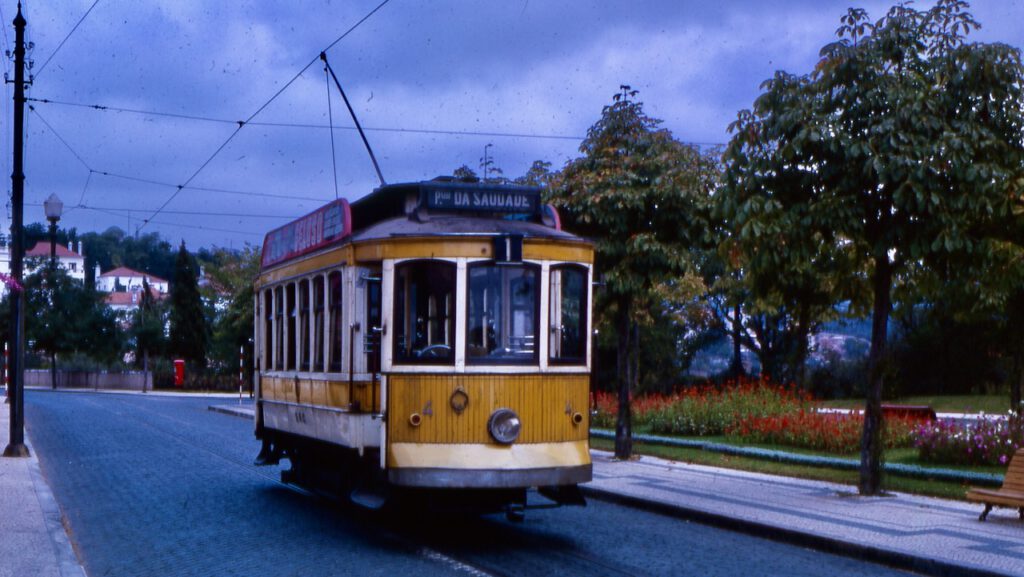
The first five trams were ordered in October 1909. The trams arrived in Coimbra in June 1910. Brill was used to send overseas orders “knocked-down” to save shipping space. Likely that happened with the Coimbra trams too and the trams had to be assembled after arrival. Test riding started in November 1910 and the services were started with these five trams on 1 January 1911.
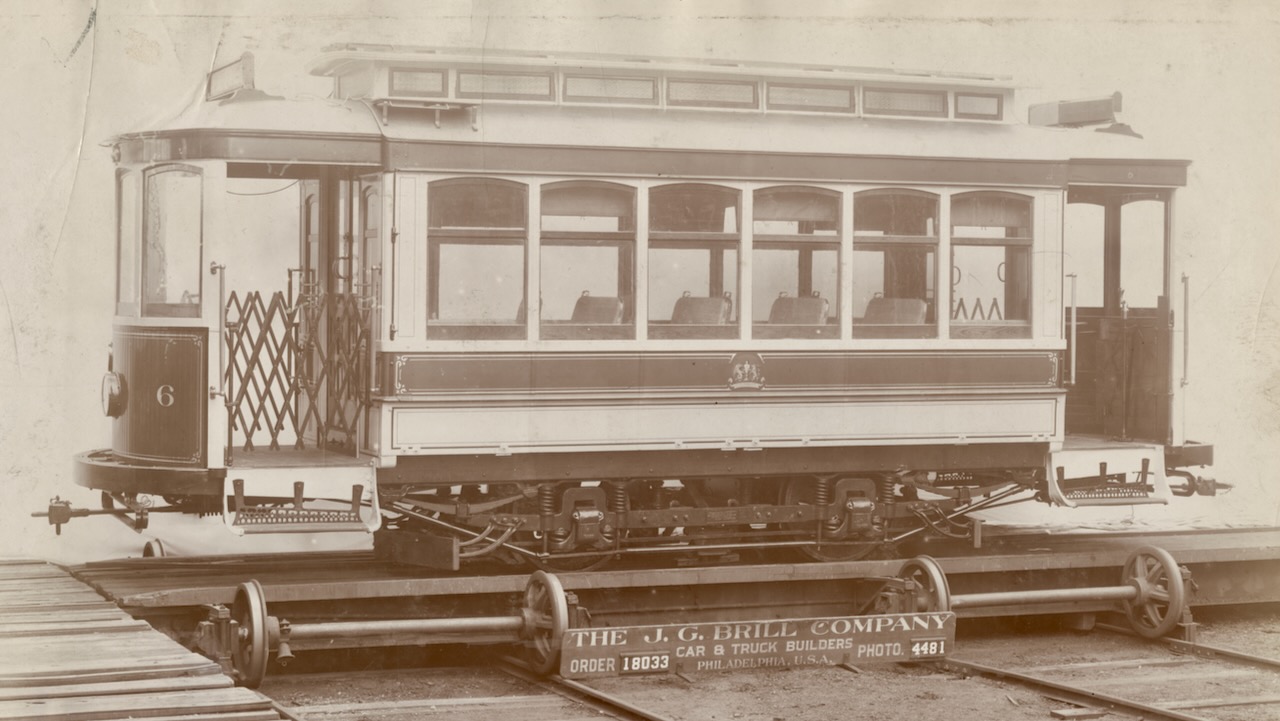
Two more trams were ordered in October 1911. These trams, numbered 6-7, entered service in May 1912.
Tram no.8 was only ordered in 1926. It entered service in the same year.
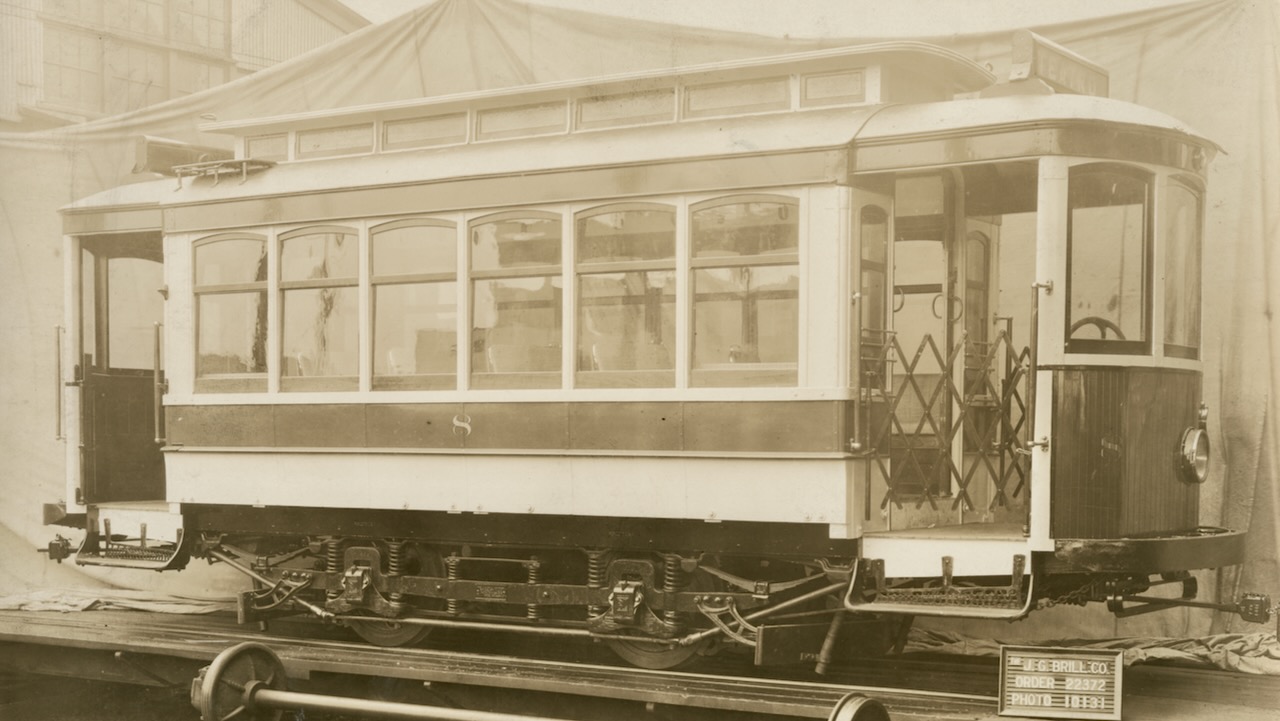
Six of these trams got new bodies of the “Standard Coimbra” style in the 1950’s and 1960’s. The other two, 2 and 8, were scrapped in 1969 and the 1970’s respectively.
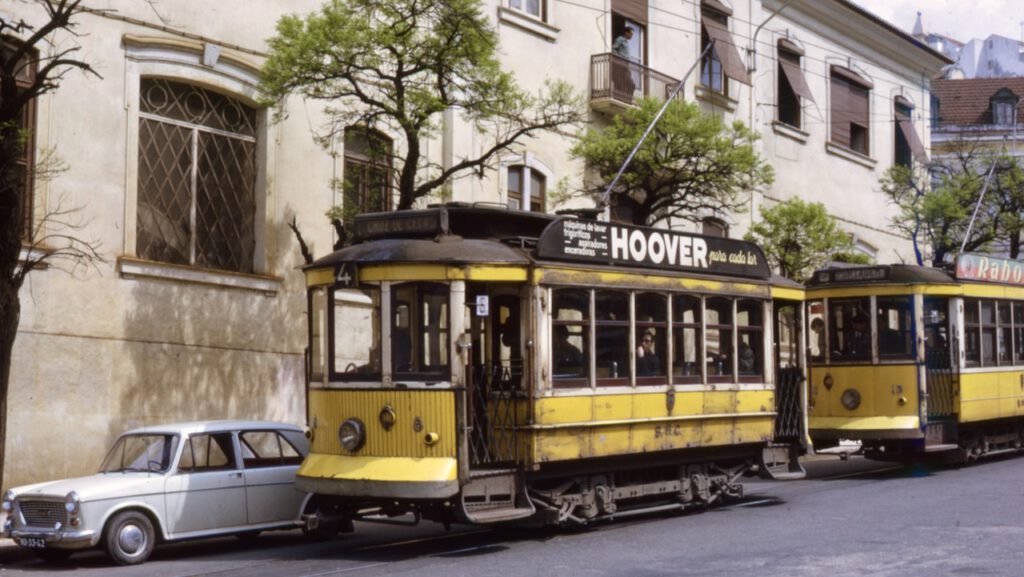
Series 9-13 Carros Pneumónicos – Fumistas – Carros Grandes
These were originally Brill built 10-bench open cross-bench cars on 21E trucks. They were ordered in 1927. The first two entered service the same year, the other three in 1928. They were highly unpopular, this in contrary to Lisboa where open cars were very popular. The open Coimbra trams got the nickname Carros Pneumónicos (Pneumonia cars).
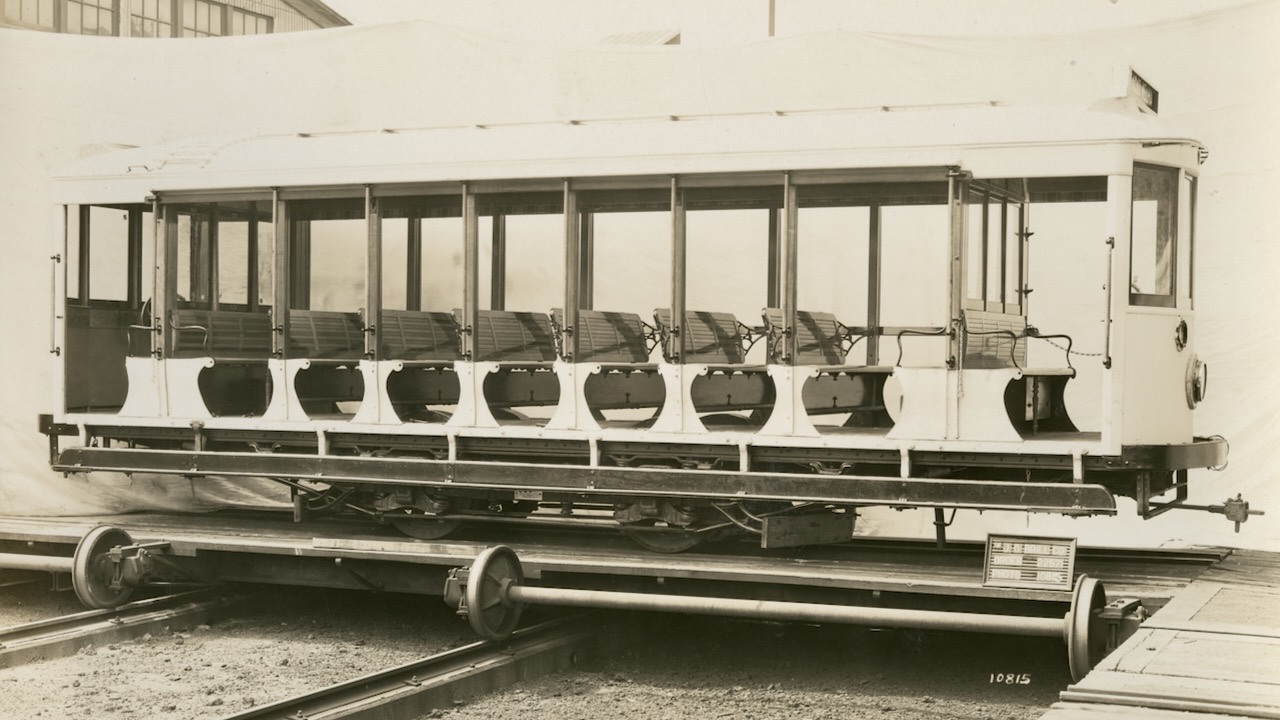
The SMC altered them in the 1930’s to convertible trams, which could be used as open cars during the Summer season and closed cars in the Winter. When operating as open trams it was allowed to smoke inside, which resulted in the new nickname Fumistas. This twice yearly conversion of removing and installing the windows had to be done by the workshops.
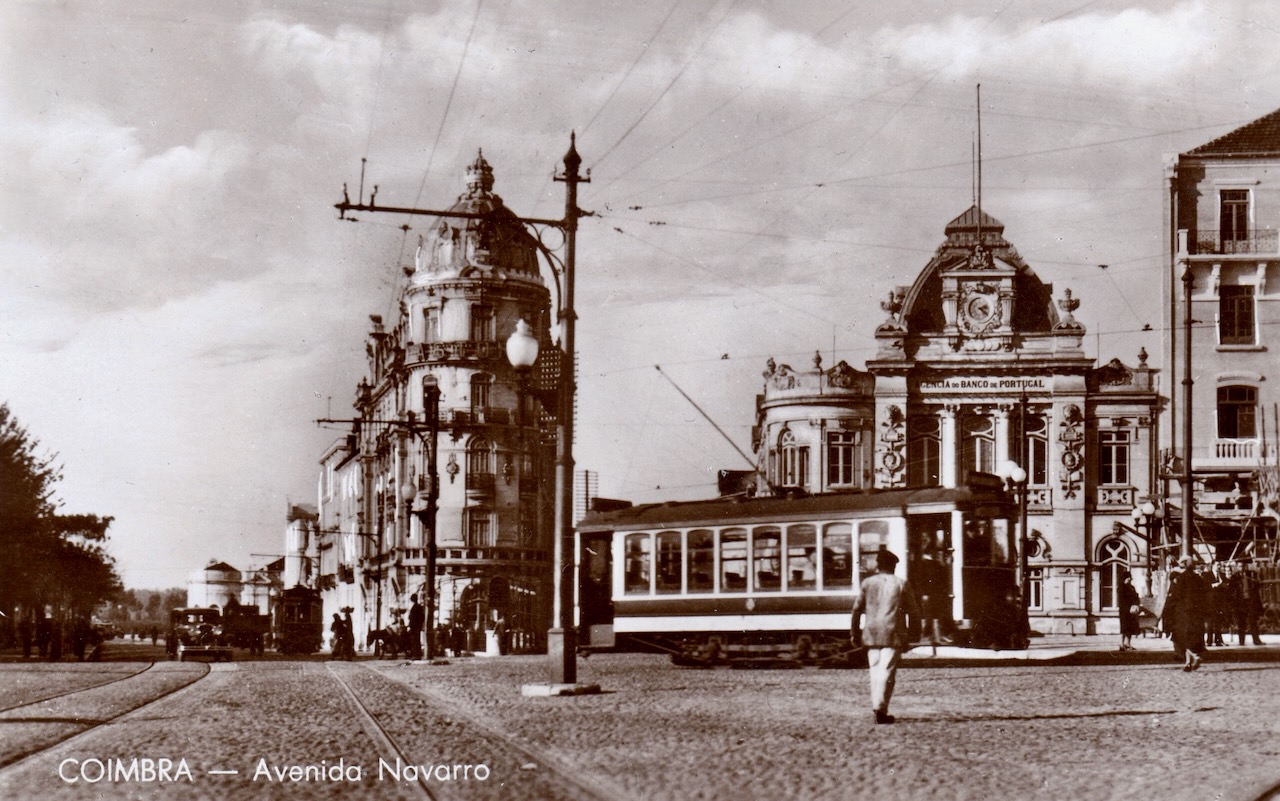
In 1941 these trams were modified again, now to make it possible that the passengers could open and close the windows themselves. As the cars were with eight bays and 26 seats significant larger than the old semi-convertible cars, they were now called Carros Grandes. All five got new, standard Coimbra style bodies, 9-12 in the 1950’s and 13 in 1966.
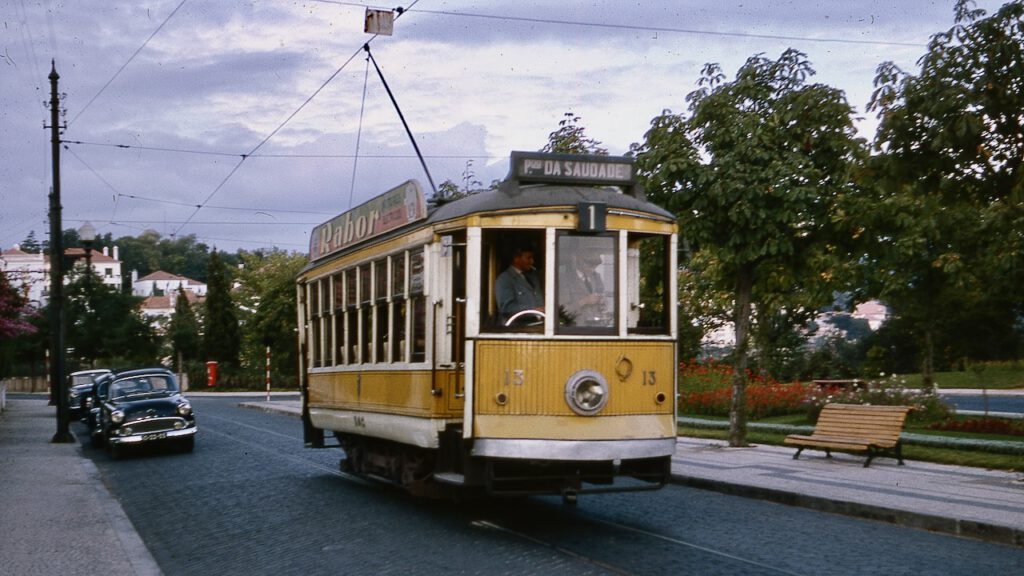
Series 14-15 Steel cars
These two closed cars were ordered from Brill in 1927 and entered service in 1928. They had 79E trucks and steel bodies seating 28: five rows with 2+2 benches and a longitudinal bench for two in each of the corners. They were a success and the example for the later built “Standard Coimbra” type bodies. Both were in service until the end of the tram operations in 1980. Car 14 even made several trips on 1 June 1981 on the at that moment still existing track between Alegria and Portagem, which the SMC wanted to retain as museum line. Alas this track was lifted a few months later.
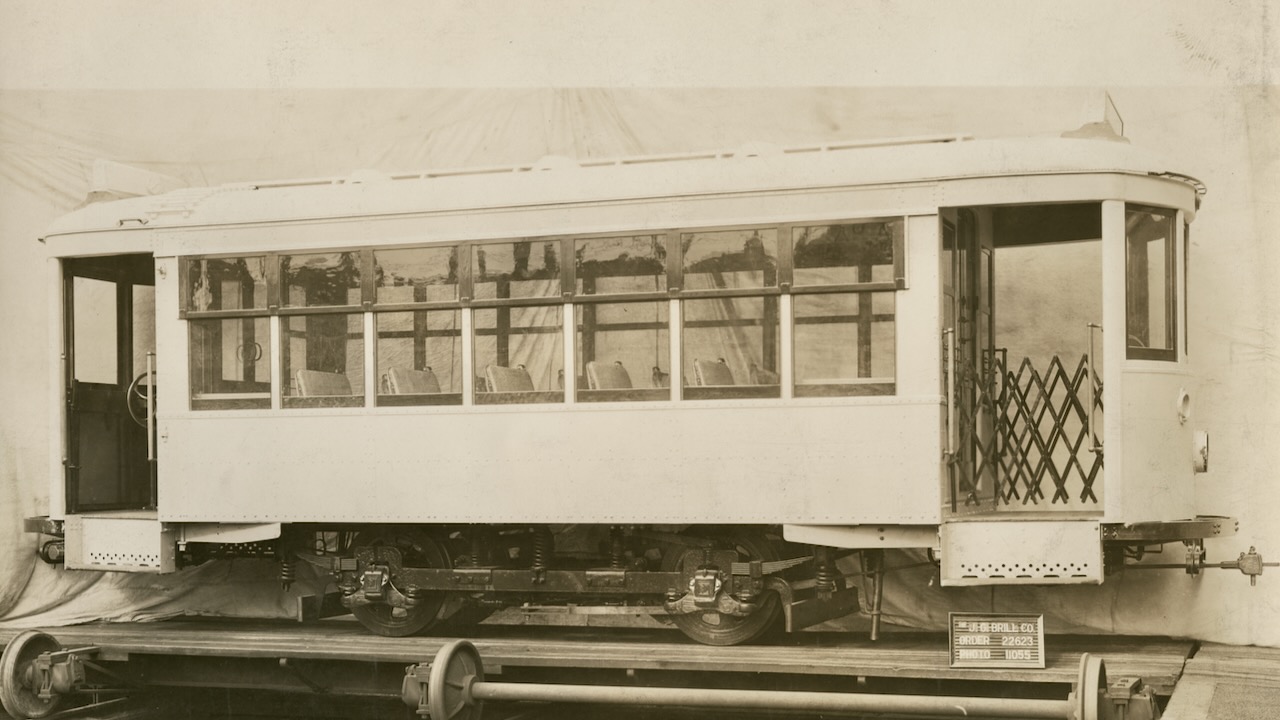
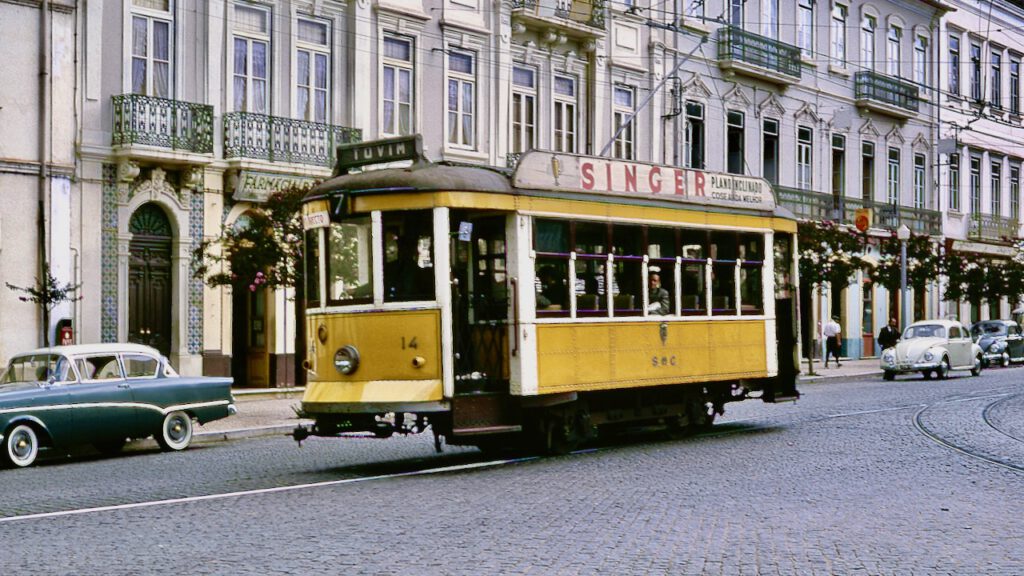
Some people referred to these trams as Birney cars, but these trams were of the classic design with end platforms separated by bulkheads from the saloon and folding gates. These two Coimbra trams had no features that made a tram a Birney Safety car: designed for one-man operation, doors controlled by the driver, impossible to run with open doors, “Deadman” control.
Series 16-18 Belgas
These three trams were ordered from the Ateliers Familleureux (Belgium) in 1929. The trucks were made in Germany by MAN. They entered service in 1930 and were the small two-axle version of the ten bogie trams ordered by the CCFP (Porto) in 1928. The original German equipment was replaced in 1948-53 by BTH motors and controllers. They were the only Coimbra cars with Westinghouse air brakes, which were installed in 1955. All three were withdrawn from service in 1973.
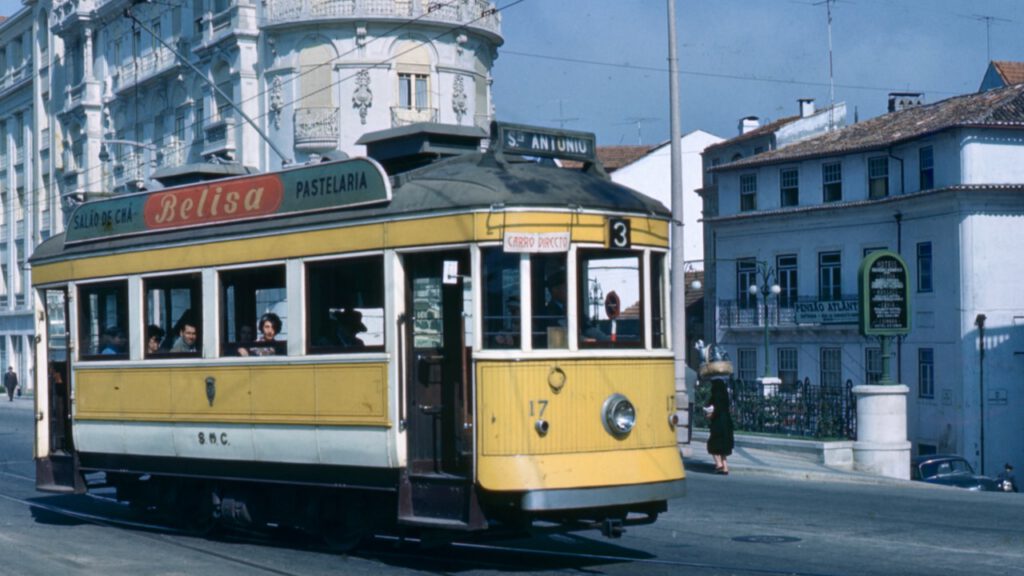
Series 19-20 Standard Coimbra
In 1934 the workshops of the CCFP in Porto built the body for tramcar no.19 to the same design as those of the cars 14-15, but made of wood instead of steel. In Coimbra it got a 79E type truck ordered from Brill. The workshops of the SMC built in 1940 the similar tram no.20, but now with the use of the Brill 21E truck that was first used with the zorra.
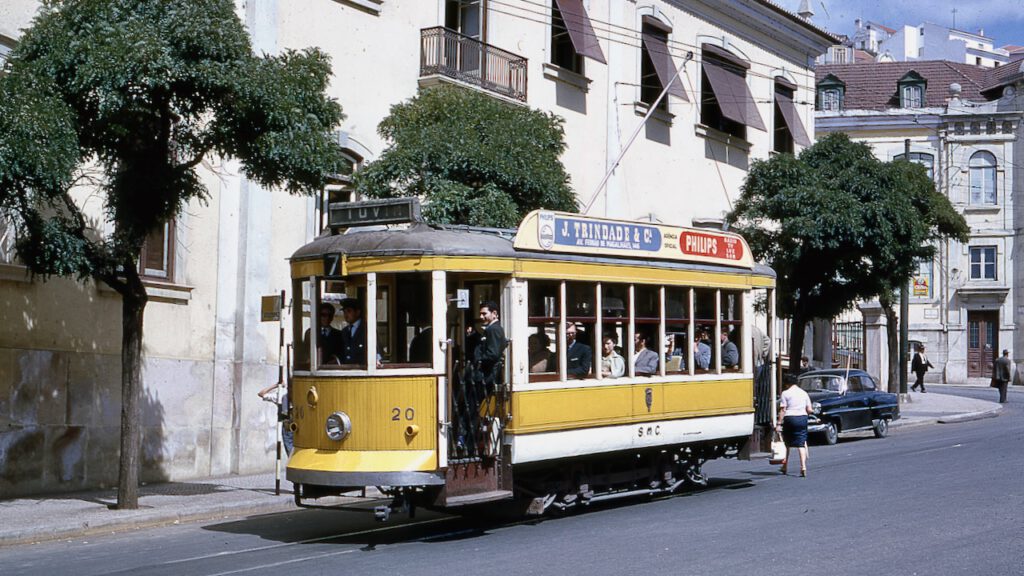
Re-bodied trams series 1, 3-7, 9-13 Standard Coimbra
During the 1950’s and 1960’s eleven of the oldest trams got new bodies to the same design as the cars 19-20. Due to the long time-span there were differences between the cars, the most prominent visible being the type of direction indicators. The cars 4, 5, 7 and 13 had the destination films embedded in the front of the roofs, while the other seven had the indicators on top of the roofs like also all older cars had. Most of these cars were in service until the end of the tram operations in 1980.
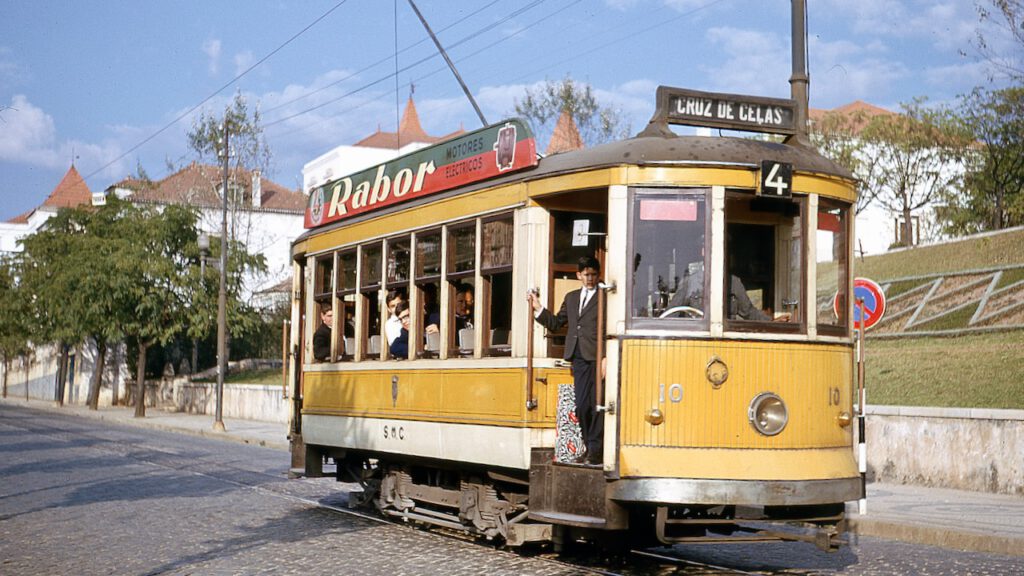
Fleet list of the Coimbra electric trams
| No. | Type (original) | In service | New standard type body | Out of service | Fate (Status August 2017) |
|---|---|---|---|---|---|
| 1 | Brill SC | 1910 | 1961 | 1980 | Museum Alegria |
| 2 | Brill SC | 1910 | na | 1969 | scrapped |
| 3 | Brill SC | 1910 | 1959 | 1980 | Museum Alegria |
| 4 | Brill SC | 1910 | 1969 | 1978 | Museum Alegria |
| 5 | Brill SC | 1910 | 1967 | 1980 | school in Solum until 1997, later scrapped |
| 6 | Brill SC | 1912 | 1959 | 1980 | Museum Alegria |
| 7 | Brill SC | 1912 | 1967 | 1979 | school in Sto.António dos Olivais, later scrapped |
| 8 | Brill SC | 1926 | na | 1970’s | scrapped |
| 9 | open | 1927 | 1957 | 1980 | scrapped in 1983 |
| 10 | open | 1927 | 1956 | 1970’s | scrapped |
| 11 | open | 1928 | 1950’s | 1980 | Museum Alegria |
| 12 | open | 1928 | 1957 | 1979 | playground P.Saudade until 1997, later scrapped |
| 13 | open | 1928 | 1966 | 1980 | Portugal dos Pequenitos until 1997, later scrapped |
| 14 | steel | 1928 | na | 1980 | Museum Alegria |
| 15 | steel | 1928 | na | 1980 | Museum Alegria |
| 16 | Belga | 1930 | na | 1973 | Museum Alegria |
| 17 | Belga | 1930 | na | 1973 | truck scrapped, body sold, current status unknown |
| 18 | Belga | 1930 | na | 1973 | truck scrapped, body sold, current status unknown |
| 19 | standard | 1934 | na | 1970’s | scrapped |
| 20 | standard | 1940 | na | 1980 | school in Solum until 1997, later scrapped |
Trailers
There were two trailers used with the electric fleet. Perhaps both were bought by the CCFC from the CCFL in Lisboa and later re-gauged by the CMC from 900 mm to 1000 mm. But they might have been acquired directly by the CMC from the CCFL as trailer usage in Coimbra started only in 1919, a period that the CCFL abandoned part of its oldest trailer fleet. Trailer no.1 was a closed former mule car built by John Stephenson (New York). Trailer no.2 was originally an open mule tram. In the 1930’s it got a closed body being a “copy” in wood of the trams 14 and 15, but to a reduced size: six windows at each side instead of seven, and narrower. Both trailers were withdrawn in 1954. Trailer no.1 is part of the museum collection, but needs restoration. Trailer no.2 went to a school in Bencanta. It was scrapped later.
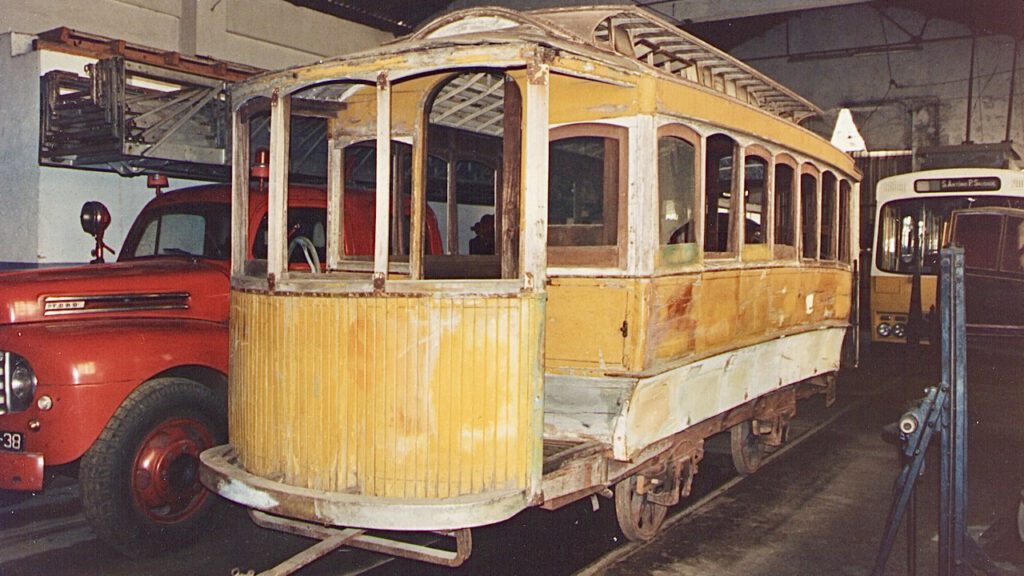
Freight trams
There were three freight cars, an electric zorra (open freight car) and two wagons. The zorra was built in 1926 on a Brill 21E truck by the Companhia Alliança in Porto, which made similar zorra’s for the Porto tram company. The car was used to bring coal from the Estação Velha to the power plant in Rua da Alegria. When the power plant was put on idle in 1933, the car got a water tank for cleaning purposes. It seems there was little use for it as in 1940 the truck was used for the construction of tram no.20.
The wagons were likely an heritage of the CCFC mule tram company and might have been used for the transport of mail bags between the post office and the Estação Velha. They had an obscure life but were retained on the fleet until 1971.
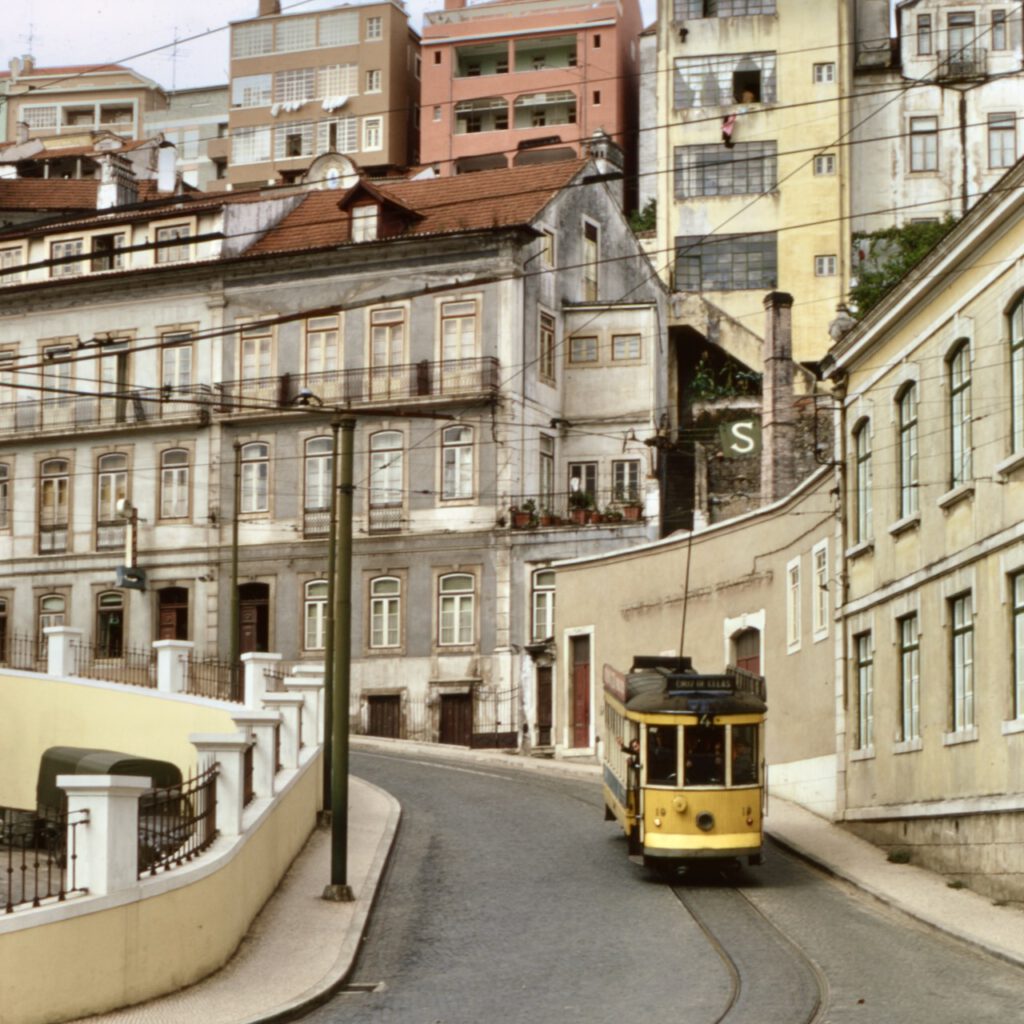
Sources
- Unpublished information given to me by my friend Pedro Rodrigues Costa. This information was for a large part based on the research done by the late Dr. Armando Mendes and the late Eng. Rocha Fontes.
- Revista STMUC: 100 anos Municipalização dos Transportes Urbanos em Coimbra (15 de Maio de 2008)
- B.R. King and J.H. Price: “The Tramways of Portugal”, published by the LRTA, several editions.
- STCP (CCFP) archives
Photos
- Brill works photos: collection of the Historical Society of Pennsylvania (USA)
- Photos made in 1995 in the Alegria museum: Ernst Kers
- Other photos and postcards: collection Ernst Kers
More photos of Coimbra trams on Flickr
©Ernst Kers


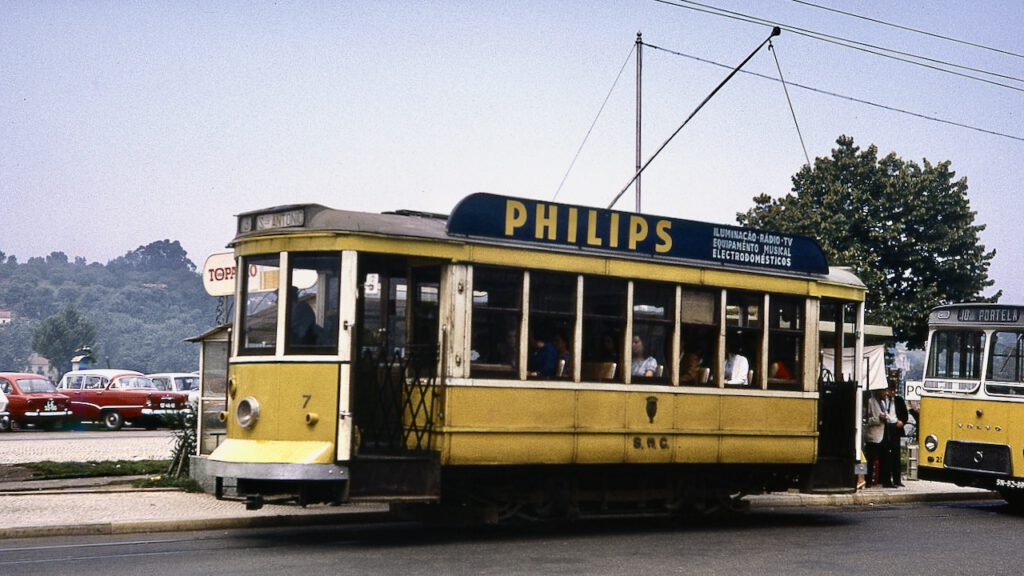
Leave a Reply